The Gender Gap in Engineering: A Review of Research and Studies
VerifiedAdded on 2023/05/30
|5
|1125
|380
Report
AI Summary
This report provides a peer review of research articles examining the gender gap in engineering and related STEM fields. The review synthesizes findings from multiple sources, including studies on women in mechanical engineering, the underrepresentation of women in the STEM workforce, and the challenges faced by female engineers in balancing career and motherhood. The report highlights the persistence of gender disparities, biases in promotion and recognition, and the need for interventions to recruit and retain women in STEM. It also discusses the importance of role models and the impact of cultural constraints on women's career choices. The analysis draws on various databases and research, providing a comprehensive overview of the issues and potential solutions to promote gender equality in engineering and STEM.
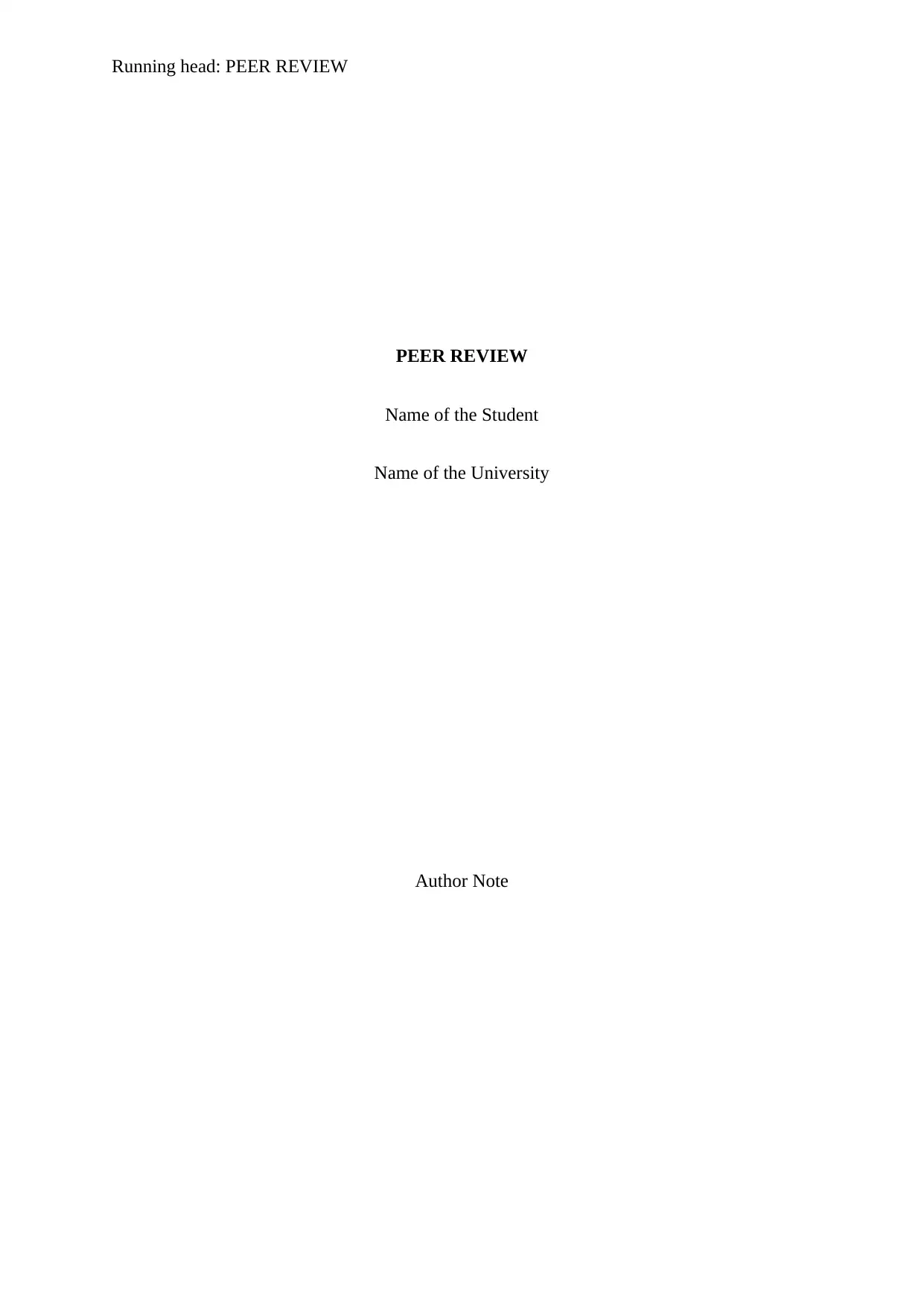
Running head: PEER REVIEW
PEER REVIEW
Name of the Student
Name of the University
Author Note
PEER REVIEW
Name of the Student
Name of the University
Author Note
Paraphrase This Document
Need a fresh take? Get an instant paraphrase of this document with our AI Paraphraser
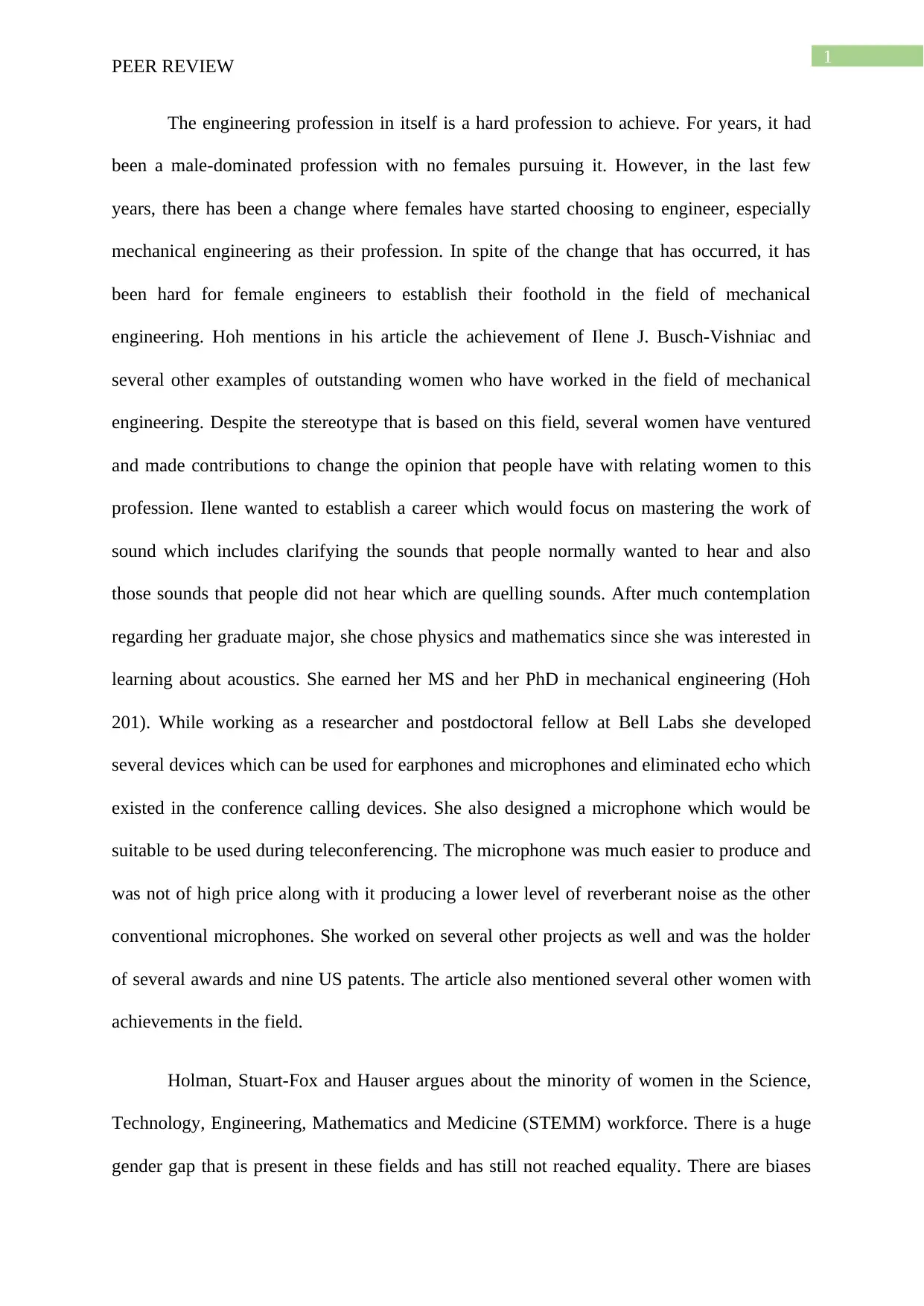
1
PEER REVIEW
The engineering profession in itself is a hard profession to achieve. For years, it had
been a male-dominated profession with no females pursuing it. However, in the last few
years, there has been a change where females have started choosing to engineer, especially
mechanical engineering as their profession. In spite of the change that has occurred, it has
been hard for female engineers to establish their foothold in the field of mechanical
engineering. Hoh mentions in his article the achievement of Ilene J. Busch-Vishniac and
several other examples of outstanding women who have worked in the field of mechanical
engineering. Despite the stereotype that is based on this field, several women have ventured
and made contributions to change the opinion that people have with relating women to this
profession. Ilene wanted to establish a career which would focus on mastering the work of
sound which includes clarifying the sounds that people normally wanted to hear and also
those sounds that people did not hear which are quelling sounds. After much contemplation
regarding her graduate major, she chose physics and mathematics since she was interested in
learning about acoustics. She earned her MS and her PhD in mechanical engineering (Hoh
201). While working as a researcher and postdoctoral fellow at Bell Labs she developed
several devices which can be used for earphones and microphones and eliminated echo which
existed in the conference calling devices. She also designed a microphone which would be
suitable to be used during teleconferencing. The microphone was much easier to produce and
was not of high price along with it producing a lower level of reverberant noise as the other
conventional microphones. She worked on several other projects as well and was the holder
of several awards and nine US patents. The article also mentioned several other women with
achievements in the field.
Holman, Stuart-Fox and Hauser argues about the minority of women in the Science,
Technology, Engineering, Mathematics and Medicine (STEMM) workforce. There is a huge
gender gap that is present in these fields and has still not reached equality. There are biases
PEER REVIEW
The engineering profession in itself is a hard profession to achieve. For years, it had
been a male-dominated profession with no females pursuing it. However, in the last few
years, there has been a change where females have started choosing to engineer, especially
mechanical engineering as their profession. In spite of the change that has occurred, it has
been hard for female engineers to establish their foothold in the field of mechanical
engineering. Hoh mentions in his article the achievement of Ilene J. Busch-Vishniac and
several other examples of outstanding women who have worked in the field of mechanical
engineering. Despite the stereotype that is based on this field, several women have ventured
and made contributions to change the opinion that people have with relating women to this
profession. Ilene wanted to establish a career which would focus on mastering the work of
sound which includes clarifying the sounds that people normally wanted to hear and also
those sounds that people did not hear which are quelling sounds. After much contemplation
regarding her graduate major, she chose physics and mathematics since she was interested in
learning about acoustics. She earned her MS and her PhD in mechanical engineering (Hoh
201). While working as a researcher and postdoctoral fellow at Bell Labs she developed
several devices which can be used for earphones and microphones and eliminated echo which
existed in the conference calling devices. She also designed a microphone which would be
suitable to be used during teleconferencing. The microphone was much easier to produce and
was not of high price along with it producing a lower level of reverberant noise as the other
conventional microphones. She worked on several other projects as well and was the holder
of several awards and nine US patents. The article also mentioned several other women with
achievements in the field.
Holman, Stuart-Fox and Hauser argues about the minority of women in the Science,
Technology, Engineering, Mathematics and Medicine (STEMM) workforce. There is a huge
gender gap that is present in these fields and has still not reached equality. There are biases
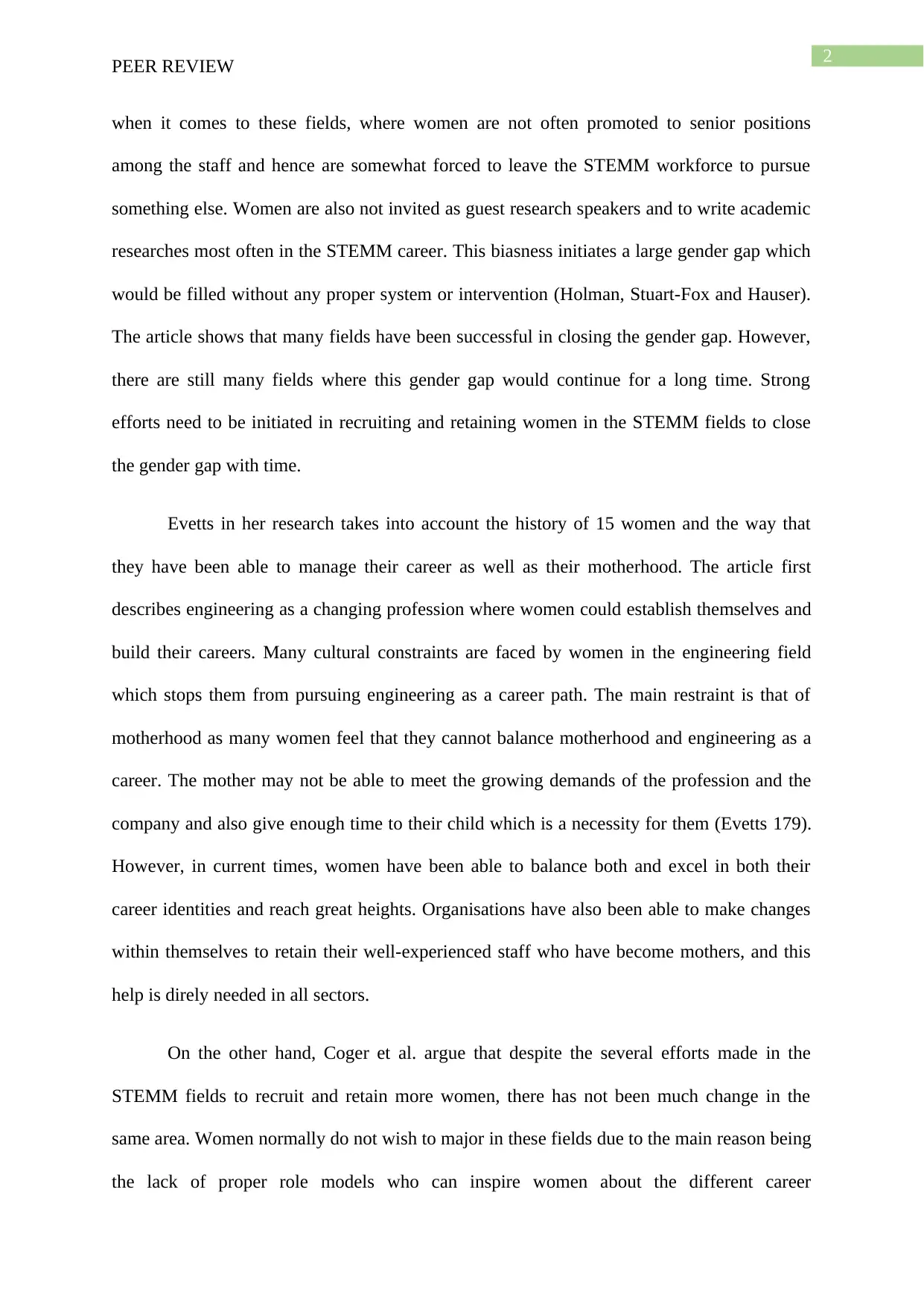
2
PEER REVIEW
when it comes to these fields, where women are not often promoted to senior positions
among the staff and hence are somewhat forced to leave the STEMM workforce to pursue
something else. Women are also not invited as guest research speakers and to write academic
researches most often in the STEMM career. This biasness initiates a large gender gap which
would be filled without any proper system or intervention (Holman, Stuart-Fox and Hauser).
The article shows that many fields have been successful in closing the gender gap. However,
there are still many fields where this gender gap would continue for a long time. Strong
efforts need to be initiated in recruiting and retaining women in the STEMM fields to close
the gender gap with time.
Evetts in her research takes into account the history of 15 women and the way that
they have been able to manage their career as well as their motherhood. The article first
describes engineering as a changing profession where women could establish themselves and
build their careers. Many cultural constraints are faced by women in the engineering field
which stops them from pursuing engineering as a career path. The main restraint is that of
motherhood as many women feel that they cannot balance motherhood and engineering as a
career. The mother may not be able to meet the growing demands of the profession and the
company and also give enough time to their child which is a necessity for them (Evetts 179).
However, in current times, women have been able to balance both and excel in both their
career identities and reach great heights. Organisations have also been able to make changes
within themselves to retain their well-experienced staff who have become mothers, and this
help is direly needed in all sectors.
On the other hand, Coger et al. argue that despite the several efforts made in the
STEMM fields to recruit and retain more women, there has not been much change in the
same area. Women normally do not wish to major in these fields due to the main reason being
the lack of proper role models who can inspire women about the different career
PEER REVIEW
when it comes to these fields, where women are not often promoted to senior positions
among the staff and hence are somewhat forced to leave the STEMM workforce to pursue
something else. Women are also not invited as guest research speakers and to write academic
researches most often in the STEMM career. This biasness initiates a large gender gap which
would be filled without any proper system or intervention (Holman, Stuart-Fox and Hauser).
The article shows that many fields have been successful in closing the gender gap. However,
there are still many fields where this gender gap would continue for a long time. Strong
efforts need to be initiated in recruiting and retaining women in the STEMM fields to close
the gender gap with time.
Evetts in her research takes into account the history of 15 women and the way that
they have been able to manage their career as well as their motherhood. The article first
describes engineering as a changing profession where women could establish themselves and
build their careers. Many cultural constraints are faced by women in the engineering field
which stops them from pursuing engineering as a career path. The main restraint is that of
motherhood as many women feel that they cannot balance motherhood and engineering as a
career. The mother may not be able to meet the growing demands of the profession and the
company and also give enough time to their child which is a necessity for them (Evetts 179).
However, in current times, women have been able to balance both and excel in both their
career identities and reach great heights. Organisations have also been able to make changes
within themselves to retain their well-experienced staff who have become mothers, and this
help is direly needed in all sectors.
On the other hand, Coger et al. argue that despite the several efforts made in the
STEMM fields to recruit and retain more women, there has not been much change in the
same area. Women normally do not wish to major in these fields due to the main reason being
the lack of proper role models who can inspire women about the different career
⊘ This is a preview!⊘
Do you want full access?
Subscribe today to unlock all pages.

Trusted by 1+ million students worldwide
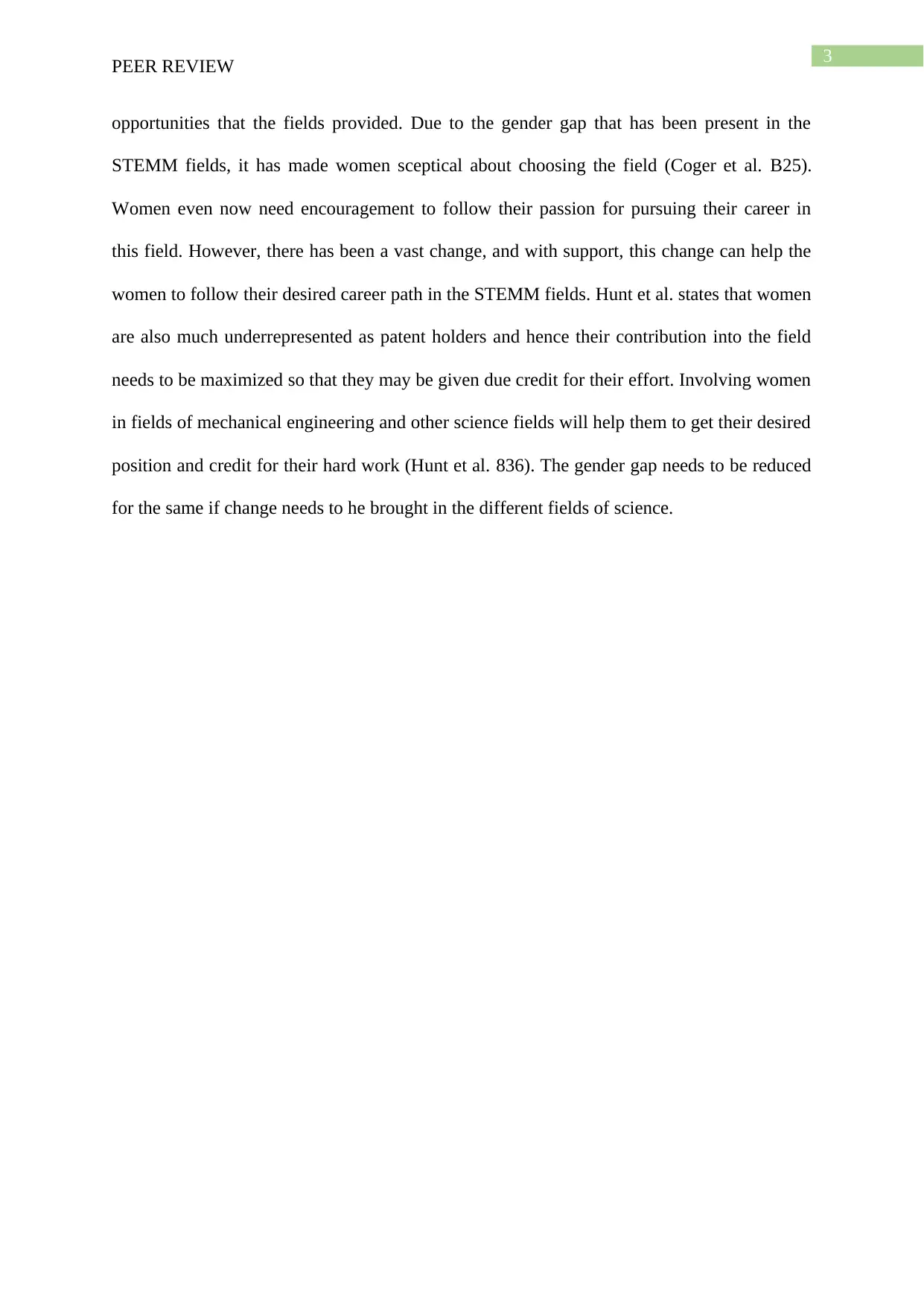
3
PEER REVIEW
opportunities that the fields provided. Due to the gender gap that has been present in the
STEMM fields, it has made women sceptical about choosing the field (Coger et al. B25).
Women even now need encouragement to follow their passion for pursuing their career in
this field. However, there has been a vast change, and with support, this change can help the
women to follow their desired career path in the STEMM fields. Hunt et al. states that women
are also much underrepresented as patent holders and hence their contribution into the field
needs to be maximized so that they may be given due credit for their effort. Involving women
in fields of mechanical engineering and other science fields will help them to get their desired
position and credit for their hard work (Hunt et al. 836). The gender gap needs to be reduced
for the same if change needs to he brought in the different fields of science.
PEER REVIEW
opportunities that the fields provided. Due to the gender gap that has been present in the
STEMM fields, it has made women sceptical about choosing the field (Coger et al. B25).
Women even now need encouragement to follow their passion for pursuing their career in
this field. However, there has been a vast change, and with support, this change can help the
women to follow their desired career path in the STEMM fields. Hunt et al. states that women
are also much underrepresented as patent holders and hence their contribution into the field
needs to be maximized so that they may be given due credit for their effort. Involving women
in fields of mechanical engineering and other science fields will help them to get their desired
position and credit for their hard work (Hunt et al. 836). The gender gap needs to be reduced
for the same if change needs to he brought in the different fields of science.
Paraphrase This Document
Need a fresh take? Get an instant paraphrase of this document with our AI Paraphraser
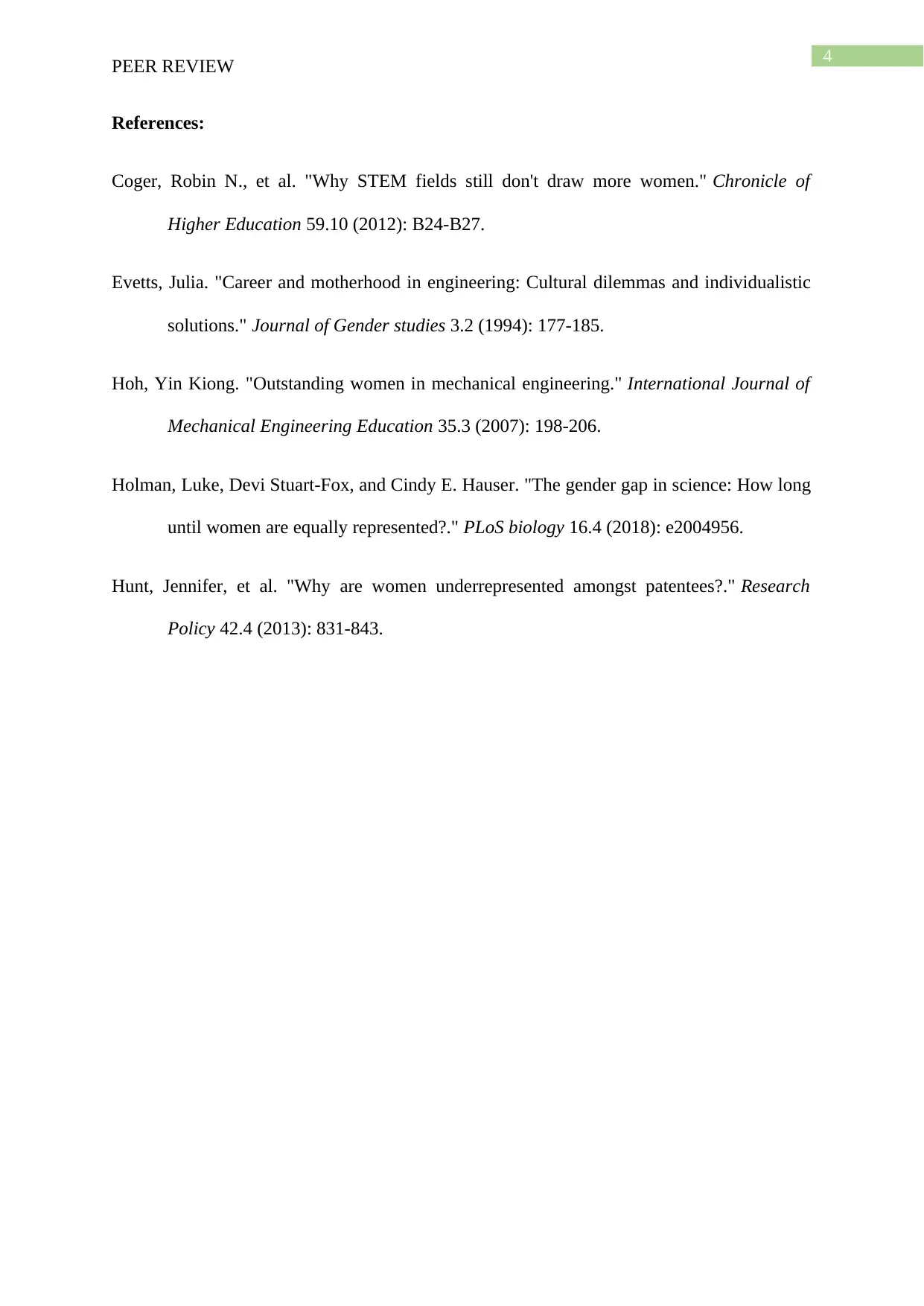
4
PEER REVIEW
References:
Coger, Robin N., et al. "Why STEM fields still don't draw more women." Chronicle of
Higher Education 59.10 (2012): B24-B27.
Evetts, Julia. "Career and motherhood in engineering: Cultural dilemmas and individualistic
solutions." Journal of Gender studies 3.2 (1994): 177-185.
Hoh, Yin Kiong. "Outstanding women in mechanical engineering." International Journal of
Mechanical Engineering Education 35.3 (2007): 198-206.
Holman, Luke, Devi Stuart-Fox, and Cindy E. Hauser. "The gender gap in science: How long
until women are equally represented?." PLoS biology 16.4 (2018): e2004956.
Hunt, Jennifer, et al. "Why are women underrepresented amongst patentees?." Research
Policy 42.4 (2013): 831-843.
PEER REVIEW
References:
Coger, Robin N., et al. "Why STEM fields still don't draw more women." Chronicle of
Higher Education 59.10 (2012): B24-B27.
Evetts, Julia. "Career and motherhood in engineering: Cultural dilemmas and individualistic
solutions." Journal of Gender studies 3.2 (1994): 177-185.
Hoh, Yin Kiong. "Outstanding women in mechanical engineering." International Journal of
Mechanical Engineering Education 35.3 (2007): 198-206.
Holman, Luke, Devi Stuart-Fox, and Cindy E. Hauser. "The gender gap in science: How long
until women are equally represented?." PLoS biology 16.4 (2018): e2004956.
Hunt, Jennifer, et al. "Why are women underrepresented amongst patentees?." Research
Policy 42.4 (2013): 831-843.
1 out of 5
Your All-in-One AI-Powered Toolkit for Academic Success.
+13062052269
info@desklib.com
Available 24*7 on WhatsApp / Email
![[object Object]](/_next/static/media/star-bottom.7253800d.svg)
Unlock your academic potential
Copyright © 2020–2025 A2Z Services. All Rights Reserved. Developed and managed by ZUCOL.